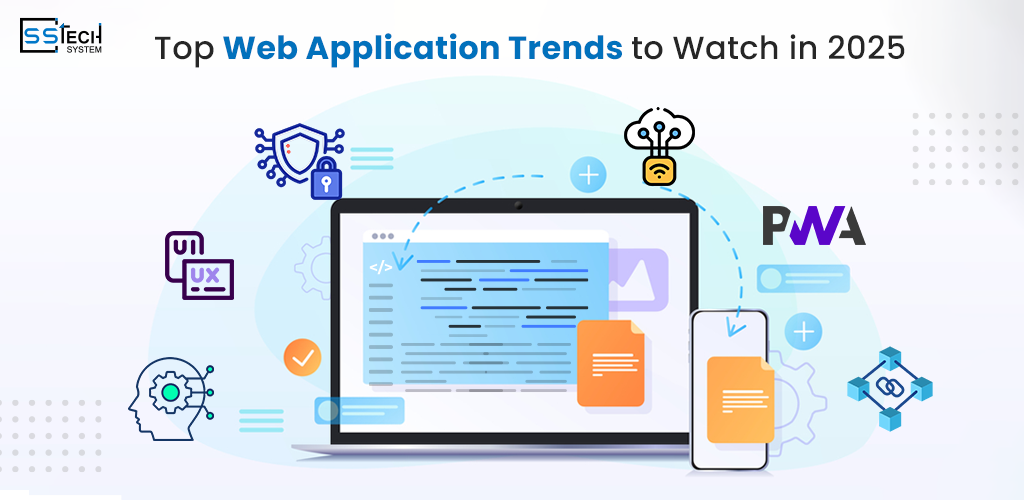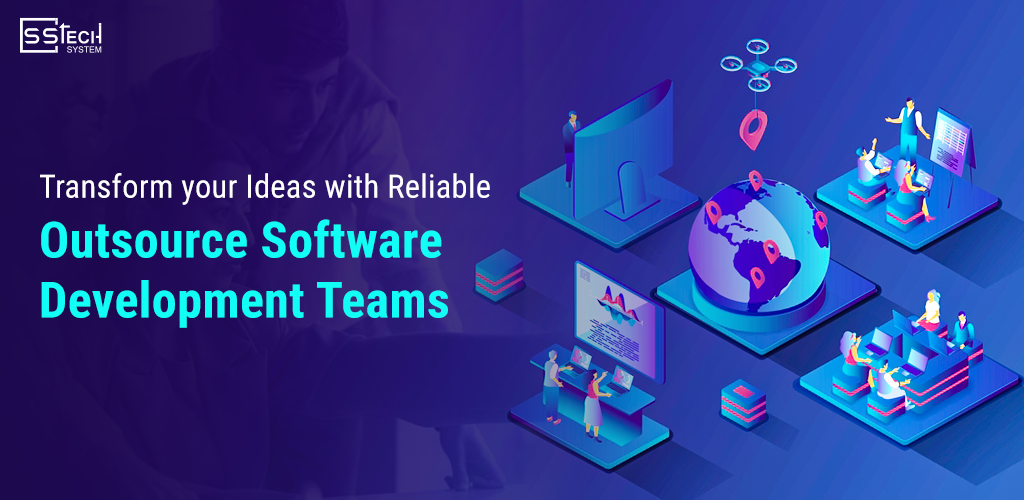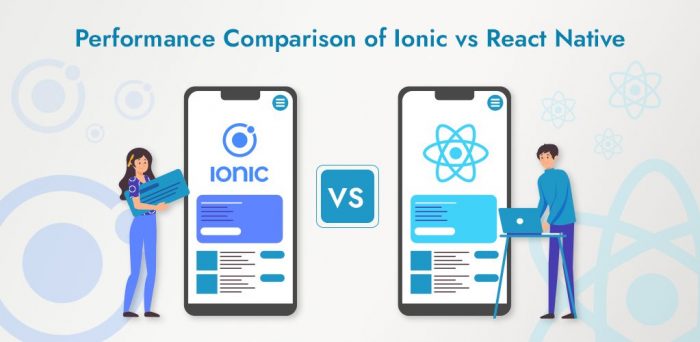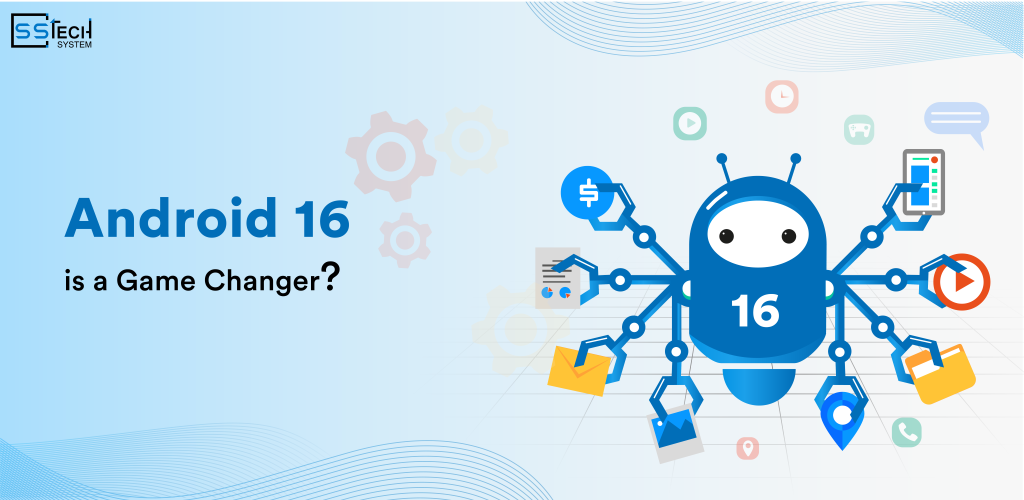
Web applications are advancing at a very high rate in order to provide industries with innovative ideas. By the year 2026, the web application industry will be expected to experience enhanced evolution and innovation due to the development of web app development technologies. AI in web applications to low-code development platforms, the future of web development looks like happier, faster, and greener. In this article, we will dive into the web application trends that define the digital world in the year 2026.
Here are the top Web Application Trends to watch.
1. Artificial Intelligence and Machine Learning in Web Applications
AI in web applications has become a common and essential part of web applications that people can no longer imagine their lives without AI. Such AI-powered applications provide unique services, streamline work, and improve productivity.
Using machine learning in web apps, businesses are able to use predictive analytics to prepare for what clients may need in the future. The Artificial Intelligence market worldwide is projected to grow by 27.67% (2025-2030) resulting in a market volume of US$826.70bn in 2030. The Australian web apps integrating AI and ML in Australian web apps are driving innovation in the country.
Key Trends:
- AI Application Development: Bringing intelligence to web applications with new and improved features.
- Chatbots: Digital customer service solutions with the help of Artificial Intelligence Conversational Agents.
- Predictive Analytics: Improved performance in decision-making since data analysis is involved.
AI-based applications have helped firms look for patterns in big data to identify trends that might be hard to notice. This makes it easy for the decision-makers to make fast and informed decisions in the competitive market.
2. Progressive Web Applications (PWAs)
Progressive web applications are a relatively new concept that is slowly filling in the gap between native and web applications. New opportunities for users are provided by offline mode, push notifications, and short loading time – that is why PWAs are changing the user experience. Using Progressive Web Application Trends Australia, it was noticed that they are widely used in eCommerce and service-based businesses in the region.
Benefits of PWAs:
- Offline usability for effortless access.
- Enhancements in the use of devices.
- Cross-platform development advantages over the native applications.
Many industries have benefited from PWA technology, but eCommerce application development has been one of the major recipients as it allows businesses to improve their online shops with the help of features similar to applications.
However, PWAs guarantee the consumers a fluid navigation experience even if the network is poor, and this is particularly important in order to keep clients located in remote zones.
3. Low-Code and No-Code Development Platforms
The availability of low-code web app development and no-code web app development has made it easy for anyone to develop software. The global low-code development platform market is predicted to generate a revenue of $187 billion by 2030. These platforms enable users who are not conversant with the technical aspects of software development to create and deploy applications and this is fast and economical.
Popular Platforms:
- Airtable for database applications.
- Bubble for visual programming.
- Mendix for the development of enterprise-level applications.
Another factor that is contributing to the increased use by startups and SMEs is the availability to hire dedicated developers to tailor low-code platforms. When organizations grow, low code enables the addition of new features and features to the applications making sure that the applications are up to the required standards.
4. Cloud-Native Web Applications
Cloud-native web applications are now the foundation of many modern business transformation initiatives due to their scalability and reliability. Real-time collaboration and improved data security, and decreased costs for infrastructure are the benefits of cloud solutions.
Key Features:
- Microservices architecture for flexibility.
- API-First development for seamless integrations.
- Enhanced scalability with cloud infrastructure.
With API integration, the deployment of microservices, and cloud-native web applications have swept across the web application architecture. This approach facilitates the ability of businesses to respond to the ever-evolving market needs without much disruption.
5. Sustainability in Web Development
Strategies for making web app development more sustainable are beginning to emerge as many companies look for ways to lessen their environmental impact. Sustainable web development is about making the best out of resources, minimizing energy usage and adopting green practices.
Strategies:
- Selecting green hosting providers.
- Enhancing the use of web performance with minimal resource consumption.
- Emphasis on the sustainability of design and function in the long run.
The sustainability drive has forced developers to use methods such as lazy loading, efficient caching, and minimalistic coding; all which are not only beneficial for the environment but also for application performance.
6. IoT-Enabled Web Applications
The Internet of things ( IoT) is integrating with the web to produce enhanced applications. IoT-enabled web applications for Australia is allowing for innovation in industries including health, transportation, and homes.
Applications:
- Real-time monitoring systems.
- Smart dashboards for IoT devices.
- Seamless integration with IoT ecosystems.
IoT application development is creating new possibilities to streamline the daily activities and the interconnectivity of things. The benefits of using IoT in business applications include enhanced operational output and reduced costs are driving its uptake in the future.
7. Enhanced UX/UI Trends in Web Apps
The concepts of user experience (UX) and user interface (UI) continue to define the look and feel of modern web application designs. UX/UI trends in web apps for 2025 include minimalism, dark mode, and engaging animations that will hold the user’s attention. According to PriceWaterhouseCoopers (PWC), 32% of customers would leave a brand they loved after just one bad experience.
Innovations:
- Voice-enabled interfaces.
- Augmented reality (AR) for immersive experiences.
- Adaptive design tailored to user preferences.
Improved UX/UI means that not only the applications will look nice, but also will have an intuitive design, which directly influences such metrics as active users and their engagement.
8. Blockchain Technology Integration
Blockchain technology integration is revolutionizing web applications in terms of security, transparency, and efficiency. From safe payment systems to supply chains, blockchain is at the forefront of integrating new solutions.
Use Cases:
- Decentralized applications (dApps).
- Secure transactions for eCommerce application development.
- Transparent voting systems.
The adoption of blockchain technology is empowering industries to eliminate middlemen, reduce costs, and ensure data integrity across the board.
9. Cybersecurity Trends for Web Applications
Cyber threats are increasing as web applications get more complex. The future cybersecurity trends for 2025 are to prevent the compromise of data and to provide secure user interactions.
Key Measures:
- AI-driven threat detection.
- Multi-factor authentication.
- End-to-end encryption for secure communication.
SSTech System and other top companies are constantly working at the forefront of improving cybersecurity products for global businesses. Building cybersecurity measures on applications from the onset helps to protect applications from new and emerging threats.
10. React JS Development and Framework Innovations
Front-end development is still led by the React JS in the world of web application development. Due to its modularity and the number of resources available, it is a popular solution among developers.
Advantages:
- High performance for dynamic web apps.
- Reusable components for faster development.
- Strong community support.
There are also Angular, Vue.js, and Svelte that are also becoming popular in the industry for web app development. These frameworks enable the developers to create applications that are both user-friendly and efficient with their performance.
11. API-First Development
As connected systems are more and more common, API-first development is now widespread. This way the flow of data between web apps, mobile apps and other third-party services becomes almost effortless.
Benefits:
- Faster time-to-market for applications.
- Enhanced scalability and flexibility.
- Simplified updates and maintenance.
API-first approaches facilitate the cooperation between development teams and promote new functionality development with a shorter time to market.
12. AI and ML in Australian Web Applications
The deployment of artificial intelligence and machine learning in web app development is currently most prominent in Australia. From health care to e-commerce, AI and ML integration in Australian web apps has made it easier for companies to work more efficiently and improve the services they offer to customers.
Success Stories:
- AI-powered chatbots for local businesses.
- Machine learning algorithms for predictive analytics.
- Intelligent automation in service-based industries.
The adoption of Artificial Intelligence and Machine Learning in Australian Web Apps is a strategic move that is inspiring other areas to follow the same suit.
Conclusion
The web application trends for 2025 are envisaged to be a future full of innovation, effectiveness and user-oriented design. Whether you have AI-powered applications to progressive web applications, or even instant apps, businesses must adopt these trends. The enhancements in the web application development arena, backing sustainable approaches, and the use of modern technologies are some of the factors that guarantee growth in the industry.
In the future, the effectiveness of React JS development, API integration, and IoT application development will play a crucial role in the growth of web applications. Whether you are a startup or a large corporation, following these trends will help you maintain a strong and effective digital presence.
Thus, by planning for these trends in advance, companies will be able to capture the market and lead the way in the development of web applications in the future.











